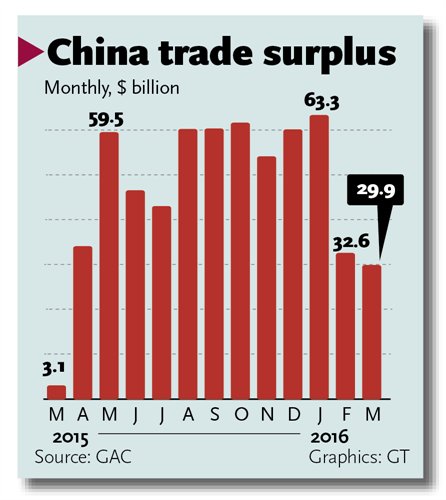
Seasonal factors contribute to first expansion in 9 months
China's exports expanded in March for the first time in nine months mainly supported by seasonal factors, and are not likely to be sustained as overseas demand remains weak, analysts said.
Exports in yuan-denominated terms rose 18.7 percent in March from the same month last year to 1.05 trillion yuan ($162.23 billion), according to data released by the General Administration of Customs (GAC) on Wednesday.
The rise represents a strong rebound from February's 20.6-percent drop and January's 6.6-percent decline.
Imports also stabilized, dipping 1.7 percent from the previous year in yuan terms, but narrowed from February's 8-percent drop and January's 14.4 percent, according to the GAC.
Experts attributed the strong trade performance to seasonal factors because economic conditions both at home and abroad haven't improved significantly.
"There might have been some improvements in some areas, but trade in March looked strong compared to a very low base number last year," said Li Jian, a research fellow at the Chinese Academy of International Trade and Economic Cooperation (CAITEC) under the Ministry of Commerce.
The Chinese Lunar Year started late in the second half of February in 2015, and workers didn't return to work until early March, which contributed to very low trade numbers for the month, Li told the Global Times on Wednesday.
"March 2015 was the largest contraction in China's merchandise exports for 2015, falling 15.1 percent, creating a weak and thus relatively easy base to grow against in 2016," Brian Jackson, China economist at IHS Global Insight, wrote in a note sent to the Global Times on Wednesday.
Support policies from the government might also have helped, according to Li. "The government has been taking measures such as cutting red tape and reducing the financial burden on companies to boost exports," Li said.
External factors
Despite signs of a rebound, the March figures do not reflect a full recovery, and challenges remain, as both exports and imports still declined in the first quarter, experts said.
First quarter exports dropped 4.2 percent year-on-year, and imports declined 8.2 percent, according to GAC data.
Sluggish global demand and rising costs continued to drag down China's exports and imports performance in the quarter, according to Huang Songping, a GAC spokesman.
"The global economy remains on track for tepid growth as global trade undergoes an adjustment period, thus constraining our exports," Huang told a briefing in Beijing on Wednesday, pointing to recent forecasts of global economic growth downgrades by major international organizations.
On Tuesday, the IMF downgraded its 2016 global growth outlook by 0.2 percentage points to 3.2 percent. This was followed by the World Bank, which cut its global forecast to 2.5 percent from 2.9 percent on Monday.
Huang further pointed out that developed countries such the US and those in the European Union, as well as emerging market countries such as Brazil and India, all experienced export declines.
Protectionist measures by some countries amid sluggish demand also affected China's exports, according to Huang.
"Trade protectionism in some countries and regions has increased," said the GAC spokesman. "[China] has become the country that suffers most from trade frictions."
Aside from weak external demand, rising costs in China also hurt exports, said Huang, noting labor, land and financing costs have increased in China, which drives some industries and orders out of the country.
Additional measures
"All these challenges will not go away anytime soon," said Li, adding more measures are needed to boost exports.
In addition to creating a favorable environment for trade by further cutting red tape and further reducing the financial burden on some companies, China should continue to solve trade issues with other countries, Li said. He also suggested that the yuan be kept stable to boost exporter confidence.
Meanwhile, the government should pursue restructuring plans, especially supply-side reforms, to transform and upgrade industries to boost global competiveness, Song Fengming, director of the Department of Finance at Tsinghua University, told the Global Times on Wednesday.
"In the end, our products will have to compete with others, and we need to make them better," said Song.


















































